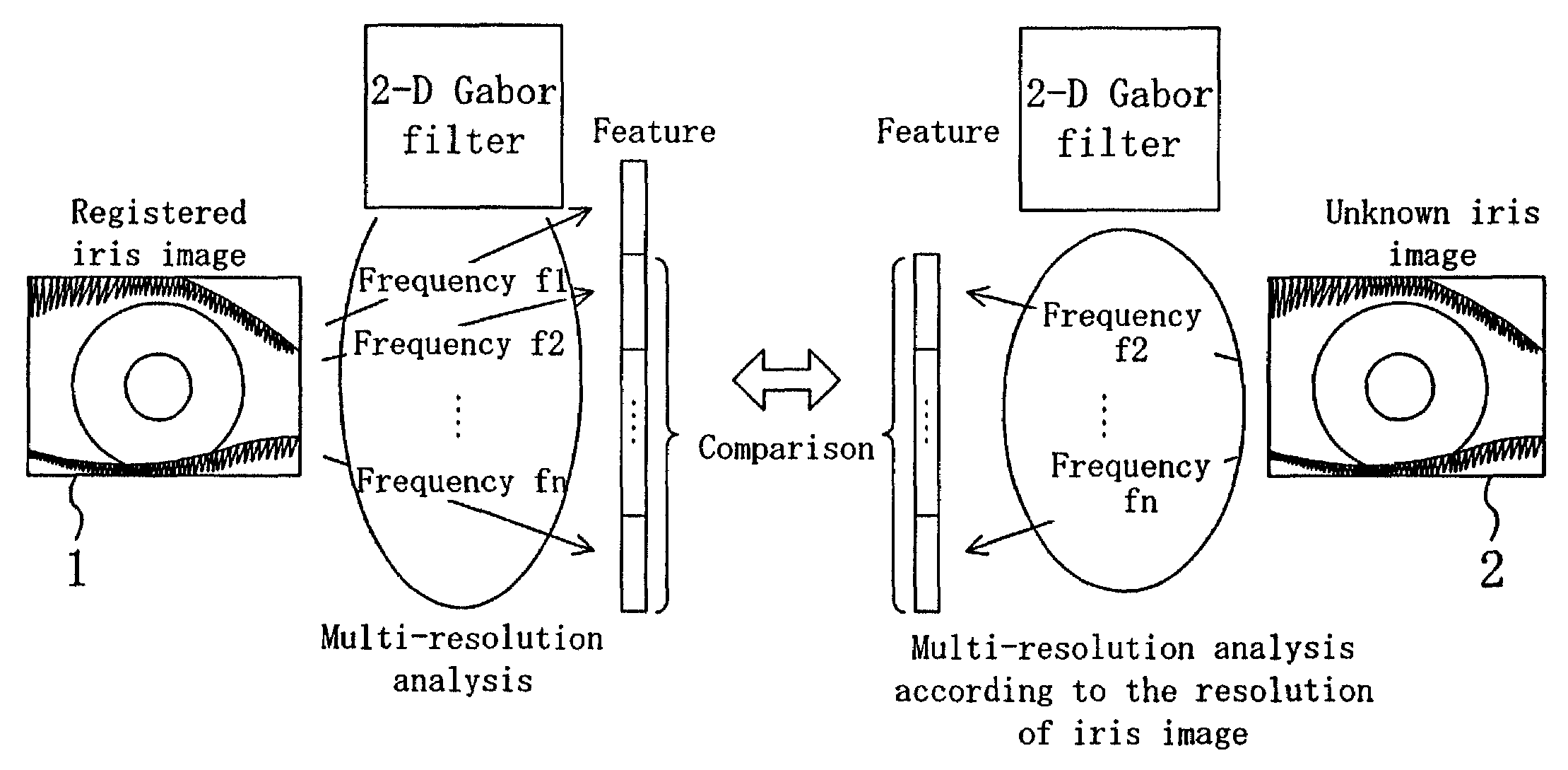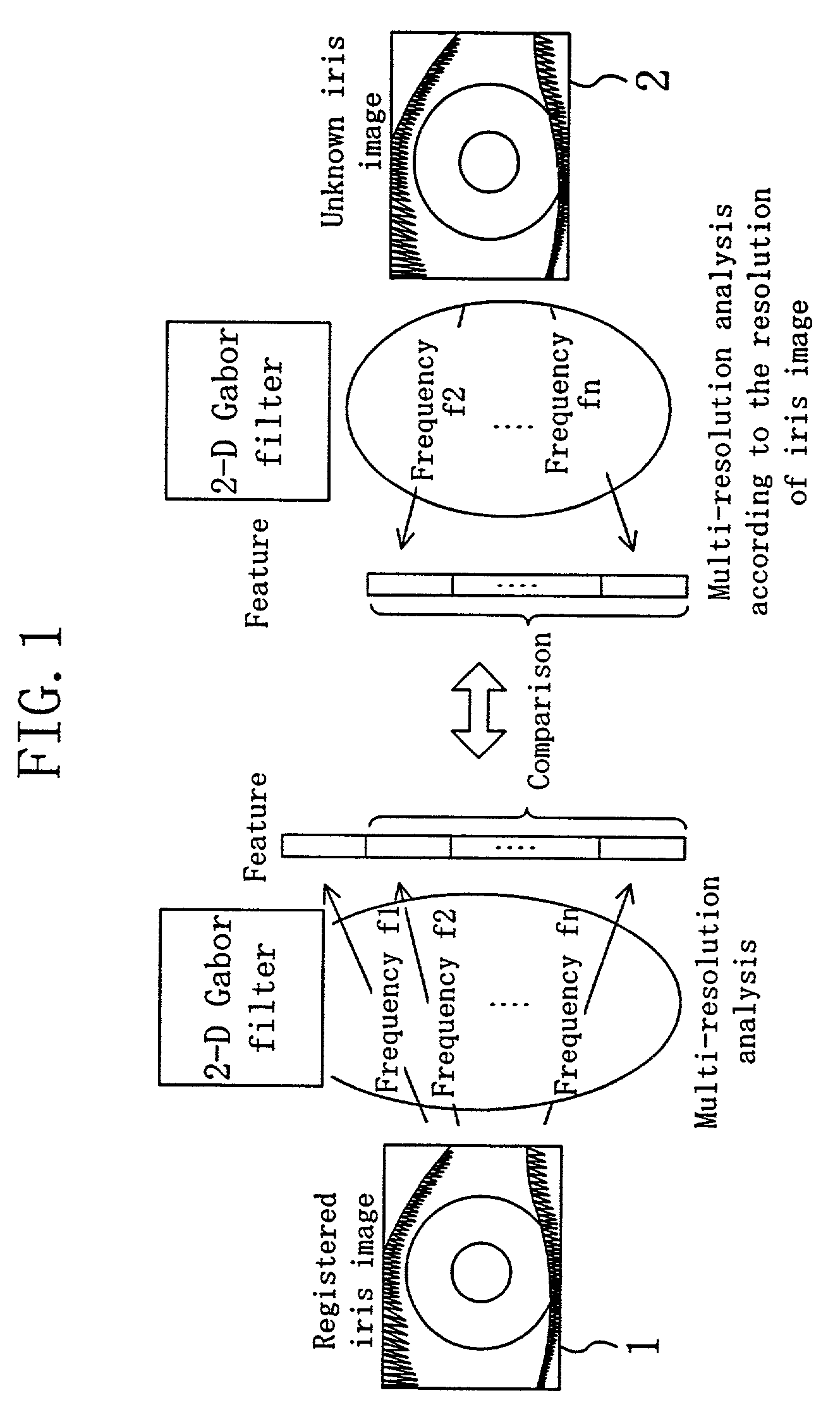Frequency and resolution analyzed biometric authentication method and device
- Summary
- Abstract
- Description
- Claims
- Application Information
AI Technical Summary
Benefits of technology
Problems solved by technology
Method used
Image
Examples
embodiment 1
[0045]FIG. 1 is a conceptual illustration of technical features of a personal authentication method of Embodiment 1 of the present invention. As shown in FIG. 1, in this embodiment, during registration, frequency analysis at a plurality of frequencies f1 to fn is performed for an iris image 1 taken, and features are generated for the respective frequencies f1 to fn. During authentication, the frequencies f2 to fn among the plurality of frequencies f1 to fn used during the registration are selected for use in frequency analysis for authentication based on the resolution of an iris image 2 taken. Frequency analysis at the selected frequencies f2 to fn is performed for the iris image 2 of a person to be authenticated, to generate features for the respective frequencies f2 to fn. The generated respective features are compared with those for the same frequencies obtained during the registration, to perform personal authentication.
[0046]By adopting the method described above, even when an...
embodiment 2
[0100]When the image capture device used during the authentication is low in resolution, no sub-feature for a high-resolution portion in multi-resolution analysis (no feature from analysis at a frequency equal to or more than the upper-limit frequency Fmp=Fsp / 2) is extracted and thus used for comparison. This reduces the total number of bits (information amount) of features used for comparison. Due to the decrease in information amount, the separability of a comparison score distribution for an identical person from that for different persons may be low, and this may degrade comparison precision.
[0101]FIG. 16 conceptually shows a distribution D1 of authentication distances between identical persons and a distribution D2 of authentication distances between different persons, obtained by comparing features in combinations of arbitrary persons. In FIG. 16, when a threshold TH for distinguishing the identical person from other persons is set as illustrated, the part of the distribution ...
embodiment 3
[0128]In Embodiment 1, an iris image was taken with an image capture device providing a comparatively high resolution capable of taking an iris image with an adequate resolution during the registration. Thereafter, multi-resolution analysis was performed to extract a sub-feature for each analysis frequency band. During the authentication, at least one frequency band for analysis is determined from the iris image taken. Sub-features obtained for the same frequency band during the registration and during the authentication were compared with each other, to perform personal authentication.
[0129]In Embodiment 3 of the present invention, a plurality of iris images with different resolutions are acquired during the registration.
[0130]Such iris images with different resolutions may be acquired by actually taking a plurality of iris images with different resolutions. This can be done using a plurality of cameras of which image capture elements provide different resolutions, or by taking ima...
PUM
 Login to View More
Login to View More Abstract
Description
Claims
Application Information
 Login to View More
Login to View More - Generate Ideas
- Intellectual Property
- Life Sciences
- Materials
- Tech Scout
- Unparalleled Data Quality
- Higher Quality Content
- 60% Fewer Hallucinations
Browse by: Latest US Patents, China's latest patents, Technical Efficacy Thesaurus, Application Domain, Technology Topic, Popular Technical Reports.
© 2025 PatSnap. All rights reserved.Legal|Privacy policy|Modern Slavery Act Transparency Statement|Sitemap|About US| Contact US: help@patsnap.com



